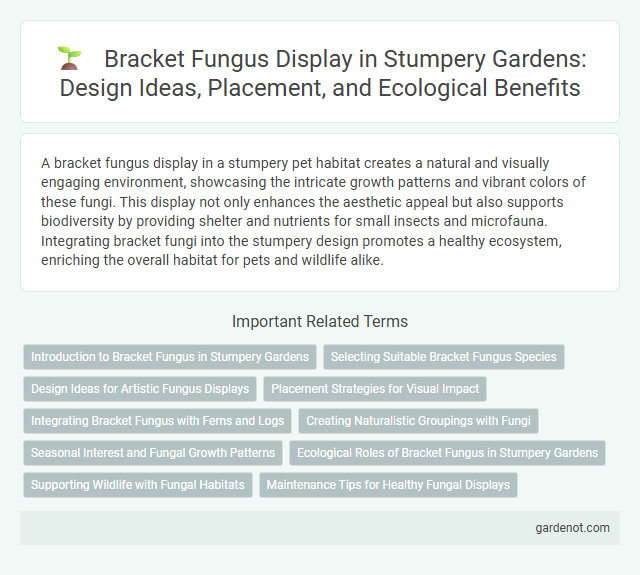A bracket fungus display in a stumpery pet habitat creates a natural and visually engaging environment, showcasing the intricate growth patterns and vibrant colors of these fungi. This display not only enhances the aesthetic appeal but also supports biodiversity by providing shelter and nutrients for small insects and microfauna. Integrating bracket fungi into the stumpery design promotes a healthy ecosystem, enriching the overall habitat for pets and wildlife alike.
Introduction to Bracket Fungus in Stumpery Gardens
Bracket fungus, a key element in stumpery gardens, thrives on decaying wood, creating intricate, shelf-like formations that enhance natural woodland aesthetics. This fungal growth plays a crucial ecological role by decomposing dead tree trunks, facilitating nutrient cycling and supporting biodiversity. Featuring a variety of species with diverse shapes and colors, bracket fungi add textural contrast and year-round interest to stumpery displays.
Selecting Suitable Bracket Fungus Species
Selecting suitable bracket fungus species for a stumpery requires focusing on hardy varieties like Ganoderma applanatum, Fomes fomentarius, and Trametes versicolor, known for their distinctive shelf-like fruiting bodies. Consider their growth patterns, ecological roles in wood decomposition, and visual appeal to create an engaging and biodiverse display. Opt for species that thrive on local tree stumps and fallen logs to ensure longevity and minimal maintenance.
Design Ideas for Artistic Fungus Displays
Creating a bracket fungus display within a stumpery involves arranging diverse polypore species to highlight their unique textures and colors against aged wood backgrounds. Incorporate varying sizes and shapes, mounting some fungi directly onto tree stumps or logs while grouping others on mossy surfaces to enhance visual depth. Use natural lighting to accentuate the fungi's pores and edges, crafting an artistic and dynamic composition that draws attention to their architectural forms.
Placement Strategies for Visual Impact
Placing bracket fungi in shaded, moist areas simulates their natural woodland habitat, enhancing authenticity and visual appeal. Arranging specimens at varying angles and heights creates dynamic texture and depth, drawing attention to their unique shelf-like forms. Integrating fungi with complementary mosses and decaying wood amplifies contrast and enriches the overall stumpery aesthetic.
Integrating Bracket Fungus with Ferns and Logs
Bracket fungus displays create a striking natural composition when integrated with ferns and logs, enhancing a stumpery's textural diversity and ecological authenticity. Positioning bracket fungi on decaying wood fosters a dynamic habitat that supports moisture retention and nutrient cycling, benefiting surrounding fern growth. This harmonious arrangement emphasizes the intricate relationships within woodland ecosystems, showcasing the stumpery as both an artistic and environmental feature.
Creating Naturalistic Groupings with Fungi
Creating naturalistic groupings with bracket fungi in a stumpery enhances biodiversity and visual interest by mimicking woodland ecosystems. Positioning clusters of Ganoderma, Trametes, and Fomes species on decaying wood surfaces promotes ecological balance and supports local wildlife. Strategic arrangement based on fungal growth patterns and substrate preferences encourages healthy development and diverse fungal communities.
Seasonal Interest and Fungal Growth Patterns
Bracket fungus displays peak in late summer to autumn, showcasing vibrant hues that contrast with the surrounding woodland decay, enhancing seasonal interest. These fungi form shelf-like structures on decaying wood, following growth patterns influenced by moisture levels and temperature fluctuations. The concentric layering of new fungal tissue each year creates visually appealing stratifications, making stumperies dynamic habitats for observing fungal development.
Ecological Roles of Bracket Fungus in Stumpery Gardens
Bracket fungi in stumpery gardens play a crucial role in nutrient cycling by decomposing deadwood, releasing essential nutrients back into the soil. Their mycelium networks support soil health and foster biodiversity by providing habitats for insects and other microorganisms. These fungi also contribute to carbon sequestration, enhancing the ecological value of stumpery ecosystems.
Supporting Wildlife with Fungal Habitats
Bracket fungi, with their shelf-like structures, provide essential habitats and food sources for various wildlife species, including insects, birds, and small mammals. These fungi contribute to biodiversity by decomposing wood and creating microhabitats within stumperies, supporting saproxylic organisms reliant on decaying wood. Encouraging bracket fungus growth in garden stumperies enhances local ecosystems by promoting fungal diversity and sustaining wildlife populations.
Maintenance Tips for Healthy Fungal Displays
Maintain moisture levels by regularly misting the bracket fungus to prevent drying and promote growth. Remove any decaying or moldy specimens promptly to avoid contamination and support overall fungal health. Ensure indirect sunlight and good air circulation to mimic natural woodland conditions and enhance the longevity of the stumpery display.
Bracket fungus display Infographic

 gardenot.com
gardenot.com